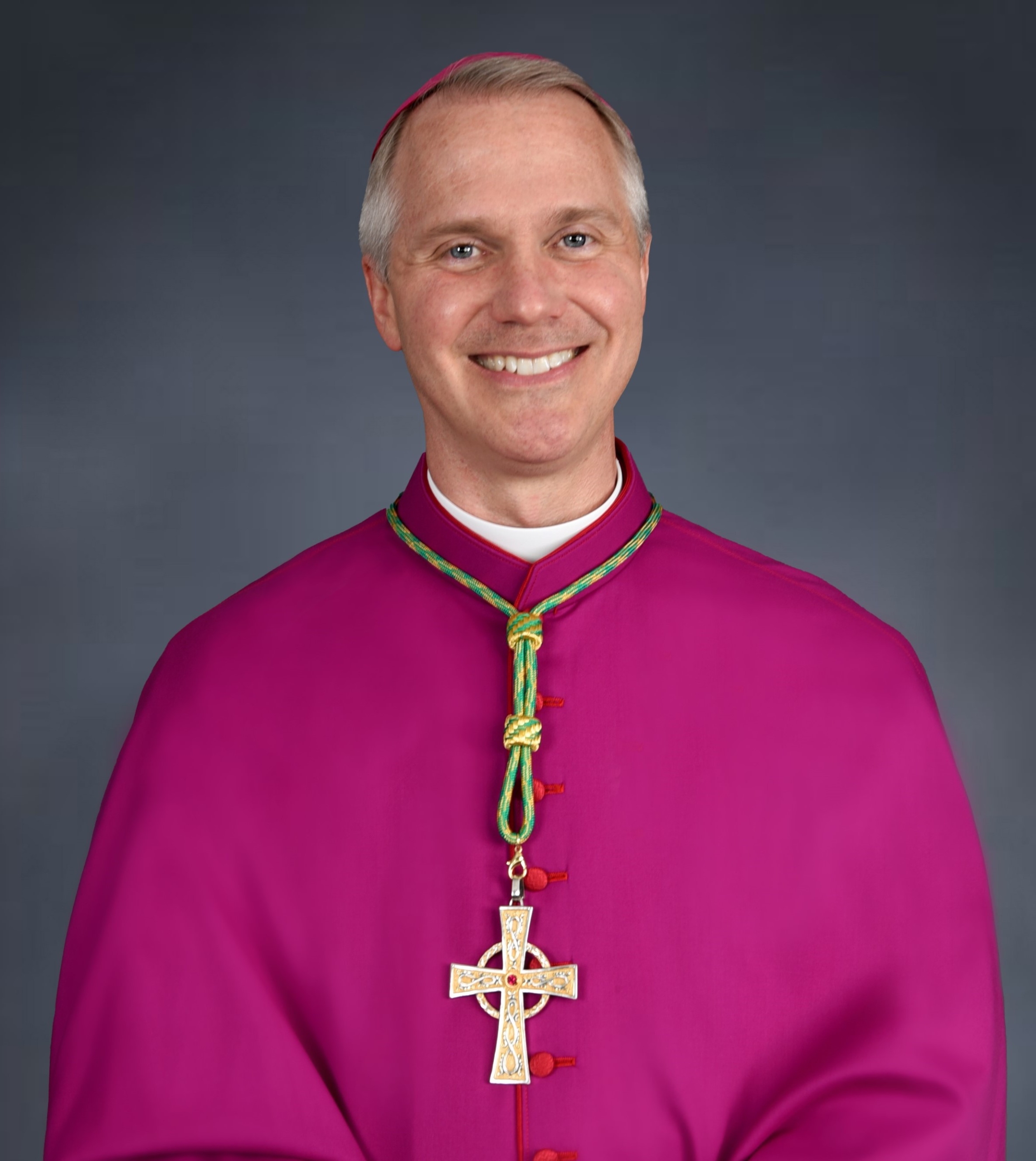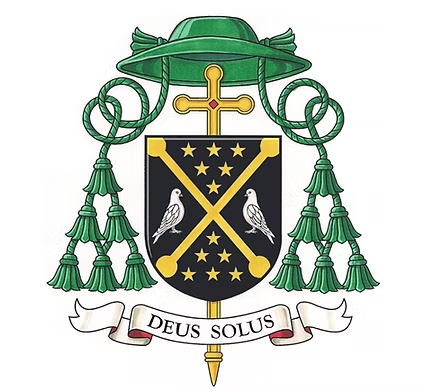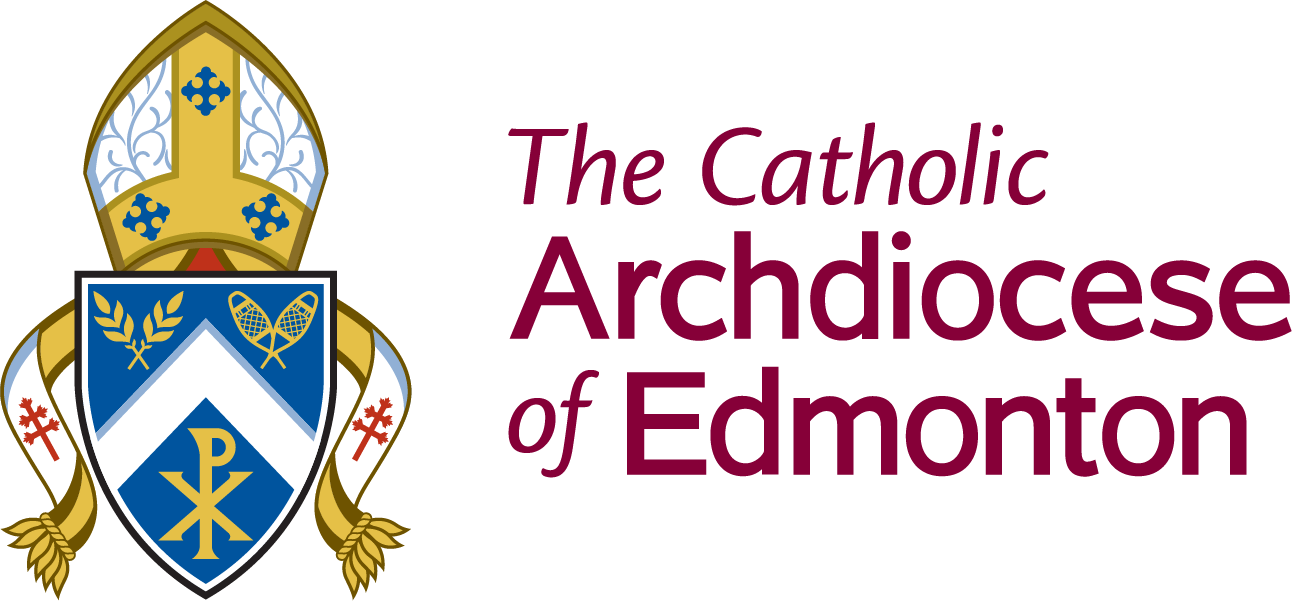Archbishop-Designate Stephen Hero
We joyfully welcome the new Archbishop who will guide our Archdiocese
Fr. Paul Kavanagh continues to serve as Archdiocesan Administrator until our new Archbishop is installed in Edmonton on January 23rd
Archbishop Stephen A. Hero will soon be the 8th Archbishop of Edmonton. The Vatican made the announcement on November 21, 2025, the Presentation of the Blessed Virgin Mary. His installation is to take place on January 23, 2026, and details are yet to be arranged.
To the Clergy and Faithful in the Archdiocese of Edmonton
Dear Brothers and Sisters:
Pope Leo XIV announced from Rome today that he has appointed me as the Metropolitan Archbishop of Edmonton. I am very humbled and grateful for the trust placed in me to take up this new mission in the Church and to serve in a community that is already close to my heart.
I spent forty years of my life in Edmonton. It is impossible to estimate how much the faith of the priests and people in the Archdiocese influenced and nurtured my own faith as a young man, fostered my call to priesthood, and helped me to grow and mature in the Lord. It is an honour to be sent to you now as your Archbishop.
Although I have a knowledge of the people and history of the Archdiocese, I look forward to returning, listening, and discerning with you how the Holy Spirit is calling us to move forward together. I have known your last three Archbishops and wish to continue to build on the wise and inspiring leadership that they gave amid the challenges of a rapidly changing world.
It has been a great joy to serve as Bishop of the Diocese of Prince Albert for the last four years. I am immensely grateful to the Clergy, religious, and lay faithful of the ‘lake country’ who have welcomed me as Shepherd and sought to serve and glorify the Lord with me. Kindly pray that the Lord will give them the Bishop they need to help to build up God’s kingdom there.
Both Prince Albert and Edmonton are in Treaty Six territory. I am eager to meet the Indigenous and Métis peoples in the Archdiocese and walk with them as well as all the many diverse peoples and cultures who now share these lands.
Today I become the Diocesan Administrator of Prince Albert until I am officially installed as the Archbishop of Edmonton on January 23, 2026. Father Paul Kavanagh continues as the Administrator of Edmonton until that time. Please pray for me, dear brothers and sisters, as I prepare to follow the Lord back to Edmonton. You are in my daily prayers as well.
Sincerely in Christ,
✠ Most Rev. Stephen A. Hero
Archbishop-Designate of Edmonton and Administrator of Prince Albert

Biography of Most Rev. Stephen A. Hero
Bishop Stephen Andrew Hero was born on 19 December 1969, in Lachine, Québec, to Louis Stephen and Kathleen Hero. He is the youngest of four siblings. The family moved to Edmonton, Alberta when he was ten years old. The stories and writings of the Saints inspired him to consider a vocation to the priesthood in his teenage years. After high school and some university studies in Classics, he earned a Bachelor of Arts (Philosophy) from the Seminary of Christ the King in Mission, British Columbia (1994) and went on to study at the Pontifical University of St. Thomas Aquinas (Angelicum) in Rome earning a Bachelor of Sacred Theology (1998) as well as a Licence in Spiritual Theology (2000). He was ordained to the priesthood on 29 June 2000 for the Archdiocese of Edmonton, where he served as an assistant pastor in parishes and as Vocations Director for the Archdiocese.
He returned to Rome to further his studies and obtained a Licence in Liturgical Theology from the Pontifical Liturgical Institute at Sant’Anselmo (2005). Upon returning to Edmonton in 2005, he served as a member of the formation team at St. Joseph Seminary and was likewise a continuing lecturer at Newman Theological College in the areas of spirituality, liturgy, and sacraments. In 2010, he was appointed as Vice Rector of St. Joseph Seminary and was later appointed Rector in 2012. He continued as Rector of the seminary until Pope Francis named him Bishop of the Diocese of Prince Albert on 25 March 2021. He was ordained Bishop in Sacred Heart Cathedral on 11 June, the Solemnity of the Sacred Heart that year.
As a member of the Canadian Conference of Catholic Bishops (CCCB), Bishop Hero has served on the Standing Committee for Relations with Movements and Associations as well as the Doctrinal Commission. He chaired the Bishops’ Working Group on Indigenous-Related Records in Diocesan Archives and is currently a member of the Episcopal Commission for Liturgy and the Sacraments. He was elected President of the Assembly of Western Catholic Bishops in 2024.
Bishop Hero began his episcopal ministry towards the end of the worldwide pandemic, and he is shepherding the people of his Diocese toward a hopeful future with a renewed sense of mission. The synodal process proposed by Pope Francis coincided with the beginnings of Bishop Hero’s service in Prince Albert and gave him a special opportunity to consult, listen, and get to know the people and their needs. He has committed himself and the Diocese to the ongoing work of reconciliation with the more than thirty First Nations who are present in the Diocese and the substantial Métis community. He feels privileged to serve and to continue to build on the dedicated ministry of his predecessors.
Bishop Hero’s motto is Deus Solus (God Alone) which is taken from Ps 86:10: “For you are great and do wondrous things; you are God alone.” It is the cry of faith that God must always be at the center of our life and love.
The Archbishop's Coat of Arms

History
Heraldry originated about a thousand years ago in Europe as a way to distinguish combatants on the battlefield. As society evolved, personal emblems were used to identify possessions and offices. Ecclesiastical heraldry grew to differentiate ranks within the Church. The Pope and most bishops adopt personal coats of arms, primarily used to identify communications from their office. Archbishop-Designate Stephen A. Hero adopted his personal coat of arms when he was appointed Bishop of Prince Albert, Saskatchewan.
Symbolism
The shield is black which represents the finiteness of the created universe, from the dark soil of the earth to the vast reaches of outer space. It is the mystery and mortality that confronts every one of us in our life as humans.
A gold Cross saltire (or X-shaped Cross) cuts across the dark shield as it does the life of every Christian. The death and resurrection of Christ is the central saving event of human history and brings the life, glory, and salvation of God to us. The saltire shape of the Cross (as opposed to the Latin Cross upon which Christ died) shows that Christ’s Cross takes its own particular form in the life of each disciple.
Bishop Hero’s patron Saints, St. Stephen of Hungary and St. Andrew the Apostle, are both recalled by this Cross saltire. The Cross atop the famous crown of St. Stephen, with rounded spheres at the end of each arm, today still tilts to the side after the king’s fall from his horse in battle. The saltire Cross is more typically linked to St. Andrew, the apostle who was ‘first called’ by the Lord (Jn 1:40), and who, after preaching God’s Word faithfully, was martyred on a Cross of this shape.
The two turtledoves in the right and left quadrants of the shield refer to St. Joseph who made this offering of the poor in the temple at Jerusalem forty days after the birth of Jesus (Luke 2:24). The use of silver or white for the doves represents Joseph’s purity of faith, spiritual poverty, and loving obedience to God in this sacrifice as in his whole life. The doves also face inward toward the Cross. It is the loving sacrifice of Christ that fulfills every other. Disciples will find strength and meaning to carry their own Cross only by looking to Christ’s. The reference to St. Joseph on the shield also recalls that Bishop Hero was born in the ‘shadow’ of St. Joseph’s Oratory in Montréal and spent sixteen years of his priesthood (nine years as Rector) at St. Joseph Seminary in Edmonton.
The upper and lower quadrants of the shield hold a total of twelve stars which evoke the figure of the Blessed Virgin Mary and her assumption into heaven. The Church’s Tradition identifies Our Lady as the woman with “a crown of twelve stars” (Rev 12:1) and she is an image of the Church already in heaven. Mary is the perfect disciple of Christ and the mother of every Christian (John 19:27). After consenting to and participating in the mystery of Christ’s Incarnation and Cross, Our Lady shares now in his glory in heaven to which we are also called. This field of gold stars on the shield shows the glory of God shining through every apparent darkness, the promise and hope of resurrection after earthly life.
St. Louis Marie de Montfort popularized a prayer called the ‘Little Crown of Our Lady,’ which consists mostly in offering twelve Hail Maries as a simple tribute of love to our Blessed Mother. The twelve stars on the shield can be taken also for these twelve Hail Maries of the Little Crown. Bishop Hero tries to practice this going ‘to Jesus through Mary’ in his own life. Praying to and with Mary is the shield of every Christian.
Finally, the use of the metals gold and silver on the black shield to represent Christ and His Saints indicates that the glory of God and the life of grace are the only true riches of Christians. In the words of St. Peter: “I have no silver or gold, but what I have I give you; in the name of Jesus Christ of Nazareth, stand up and walk.” (Acts 3:6)
Description of the Bishop’s Motto
Bishop Hero has selected for his episcopal motto the Latin words: Deus Solus or God Alone
This was the favourite saying of St. Louis Marie de Montfort, who appended it to most of his writings, and it also resembles the solo Dios basta (God alone suffices) of St. Teresa of Avila, the great Carmelite teacher of prayer.
Bishop Hero has taken it specifically from the Vulgate version of Psalms 85:10: “For you are great and do wondrous things; you are God alone” (NRSV Psalms 86:10). It is the cry of faith that God must be at the center of our life in order to love ourselves, our neighbour, and the good things of the earth rightly, that is, in God. The perennial human temptation is to make ourself, something or someone else into a sort of false god.
Who We Are
Office of the Archbishop
Rev. Paul Kavanagh
Archdiocesan Administrator
Serving until our new Archbishop, the Most Rev. Stephen A. Hero, is installed in Edmonton.
Rev. Jim Corrigan
Vicar General
NOTE: position vacant until next Archbishop is installed
Julien Hammond
Principal Secretary, Senior Lead
Suzanne Brohier
Executive Assistant to the Archdiocesan Administrator
Danielle White
Administrative Assistant to Vicar General
NOTE: position vacant until next Archbishop is installed
Rev. Philip Creurer, J.V.
Judicial Vicar
Acts in the name of the Archbishop and directs the Interdiocesan Tribunal, which assists those requesting a study of a marriage for a possible declaration of nullity. The Tribunal serves the dioceses of Edmonton, St. Paul, Grouard-McLennan and Mackenzie-Fort Smith.
Rev. Paul Kavanagh
Episcopal Vicar for Clergy
NOTE: position vacant until next Archbishop is installed
In addition, he retains his role as Mission Leadership Senior Lead.
Rev. Patrick Baska
Ecclesiastical Assistant to Catholic Social Services
In this role, he will represent the Archbishop to the Board of Directors.
Messages & Homilies
Pastoral Letters
Archbishop Stephen A. Hero
Letters by Archbishop Smith will be succeeded as our new Archbishop takes up his episcopacy here.
- 25 February 2025 – Letter to the Clergy and Faithful of the Archdiocese of Edmonton on Archbishop Smith’s Appointment as the next Archbishop of Vancouver PDF
- 10 October 2024 – Be it Done: Living in the Word – A Call to the Clergy and Lay Faithful of the Archdiocese of Edmonton
- 14 September 2017 – Living in the Word of God PDF
- 14 September 2017 – Living in the Word of God – Pastoral Initiatives Booklet PDF
